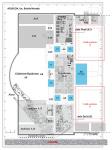Summary (English)
This season’s excavations concentrated on the north-eastern sector of the Large Baths (Sector C9), in room S20, that dates to the Constantinian phase of the complex. The organisation of the room, furnished with pools, water supply system and probably fountains, is difficult to read due to the later overlying phases and definitive robbing, which in this zone seems to date to between the 15th and 16th centuries.
Room S20 comprised a rectangular platform with a circular structure at the centre (diam. 8 m), interpretable as the bottom of a large pool. Other rectangular pools on a higher level were situated to the west, towards the North Hall. The overall dimensions of the platform were c. 13 m N-S x 16 or 20 m E-W. This year the southern limit was excavated and an attempt made to identify the eastern one, which probably lies beneath the floor of the adjacent room A14. Three courses of bricks bonded with mortar on a thick foundation of large reused stone fragments (including various columns in Cipollino marble) had survived the later robbing.
The floors of the pools rested on thick dumps of clay-silt mixed with fragments of various materials. The clay also formed the lining of the N-S water channel that must have been of the type built of bricks with rectangular section and a flat covering. The pipe, which probably served for both water distribution to, and drainage from the pools, was out of use and completely robbed when, in the second phase of the baths, room S20 was obliterated by the floor of large tesserae in room A19 (see 2017 entry). The fill obliterating the channel contained brick fragments from the channel, parts of lead fistula and numerous small re-cut polychrome marble slabs from the opus sectile revetment and numerous glass tesserae in green, blue and gold leaf, that may have decorated niches and pools with fountains. Most of these finds show traces of the effects of intense heat and suggest, together with numerous charcoal fragments, some of moderate size, that room S20 was destroyed by fire.
The excavation of the N-S robber/foundation trench separating S20 from the North Hall to the west also continued. The robbing extended towards both rooms. Towards the North Hall, the brick wall of the structure containing the make-up for the mosaic floor of the large hall was robbed out. On the edge of the trench and in the fill there were numerous slabs and blocks, some large, that had been removed from the walls and cornices surrounding the mosaic panels in the North Hall, and large fragments of concrete, perhaps from the bases of the pools.
The removal of the disturbed layers north of the building revealed substantial architectural remains, including a granite column damaged by fire, some small patches of mosaic from the North Hall and a part of the internal facing of its north wall, with the base of the marble slabs that clad the footing of the wall. Mosaics and wall revetments were already uncovered in the 1920s directed by Paola Lopreato and then back filled, but were never documented.
- Marina Rubinich – Università degli Studi di Udine (Dipartimento di Studi umanistici e del patrimonio culturale – DIUM
Director
- Marina Rubinich – Università degli Studi di Udine (Dipartimento di Studi umanistici e del patrimonio culturale – DIUM
Team
Research Body
- Università degli Studi di Udine
Funding Body
- Fondazione Aquileia
- Università degli Studi di Udine






![Download [PDF]](/excavation/skins/fasti/images/results/download_sml.png)
